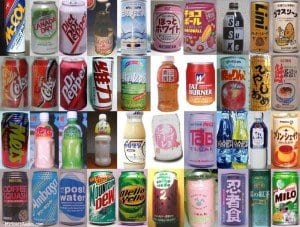 That energy drink or the next can of soda you drink may not seem like it’s doing that much harm, but people are getting an enormous amount of calories from drinks today. While mankind lived for thousands of years on water alone, we now have a huge array of tasty (and sometimes seemingly healthy) beverages available every day, from fruit juices to soda to cappuccinos, and they all have the potential to flood our bodies with an enormous number of excess calories.
That energy drink or the next can of soda you drink may not seem like it’s doing that much harm, but people are getting an enormous amount of calories from drinks today. While mankind lived for thousands of years on water alone, we now have a huge array of tasty (and sometimes seemingly healthy) beverages available every day, from fruit juices to soda to cappuccinos, and they all have the potential to flood our bodies with an enormous number of excess calories.
“It’s a huge problem,” says Katie Warwick, dietitian with the Toronto Western Hospital who works with patients who have received a recommendation for bariatric surgery. “A lot of our patients aren’t aware of how many calories they’re actually drinking. There’s the misperception that if it’s healthy, such as milk or juice, the calories don’t cause weight gain.” In other words, fruit juice may provide vitamin C and other important nutrients, but it also provides lots of energy in the form of calories, just as any other food does. And that extra energy can induce a caloric excess that causes your body to store fat.
Canadian beverage companies are beginning a two-year initiative that will emphasize the amount of calories contained in a drink right on the packaging. Similar companies in the U.S. have started a similar campaign.
Not only are we consuming more sugary and high-calorie drinks, but we’re consuming more of them in a single sitting. “For years the beverage industry considered 591-mL a multi-serve portion,” says Justin Sherwood, the president of the Canadian Beverage Association. “But our research shows that many consumers are now drinking it in one sitting.”
Data from Statistics Canada shows that middle-aged Canadian men in their 30s and 40s receive 16% of their daily caloric intake from liquids, while women receive 14.3% of their intake in liquids. In younger generations, it’s even higher: men in their 20s receive 20.4% of their calories from beverages and women 17.9%.
Those numbers are far out of line with what is considered healthy. According to Barry Popkin, a professor of nutrition at the University of North Carolina at Chapel Hill and leading obesity researcher, people should gain more like “between five and ten percent” of their daily calories from beverages.
It’s so easy to consume an excessive number of calories from beverages because they don’t activate the satiety mechanisms in our bodies the way solid foods do. The hormonal process from the gut signaling that we’re full is not fully realized when we consume calories in liquid form. Since we don’t feel full, we can consume hundreds of calories from a liquid and still feel like we need to eat some solid food.
According to Barry Popkin, “Our thirst mechanism developed separately from hunger so we could constantly drink water but eat only when food was available.” For thousands of years, mankind relied only on water; this evolutionary advantage has turned into a disadvantage as we have been exposed to tasty beverages that flood our bodies with extra calories.
Most of the offending beverages consist of simple sugars. These sugars move quickly through the gastrointestinal tract; they do not promote satiety or provide the fiber and fats that slow down digestion the way solid food does.
A recent study published in the New England Journal of Medicine found that the foods most responsible for contributing to the obesity problem include potatoes, potato chips, and high-sugar sweetened beverages.